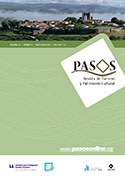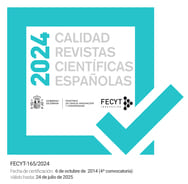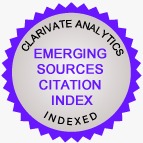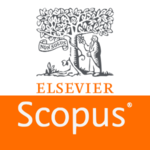The tourist semiosis of lake landscapes through aesthetics and perfomativities
DOI:
https://doi.org/10.25145/j.pasos.2025.23.023Keywords:
lake landscapes, Peircean Semiotics, Aesthetics, Performance, Mirim LagoonAbstract
We mobilized Semiotics for closer examination of visual representations of lake landscapes and bodily performativities, specifically employing type/token distinction, a remarkable feature of the sign model by Charles Sanders Peirce (1839-1914). Thus, the core goal was to address the following question from a Southern empirical semiotic lab, Mirim Lagoon (Brazil/Uruguay): How do tourists and leisure-seekers encounter lake landscapes and make sense of them in aesthetic and performative terms? We applied a qualitative methodological approach based on visual and textual information, followed by interpretational analysis informed by type/token distinction and complementarity. Visitors engage with lake landscapes visually, corporeally, and performatively regarding the materiality of these vacationscapes. The collective gaze complements and confronts conservative looking at these landscapes, still focused on Romanticism. After providing advance in current comprehension of these inter-related phenomena, we raise some questions for further examination, paralleled with practical implications.
Downloads
Publication Facts
Reviewer profiles N/A
Author statements
- Academic society
- PASOS. Revista de Turismo y Patrimonio Cultural
- Publisher
- Instituto Universitario de Investigación Social y Turismo. Universidad de La Laguna (España) - Instituto Universitario da Maia ISMAI (Portugal)
References
Banks, M. (Trans.) (2009[2008]). Dados visuais para pesquisa qualitative [Qualitative data for qualitative research]. Porto Alegre: Bookman/Artmed.
Barthes, R. (Trans.) (1986). El obvio y lo obtuso: Imágenes, gestos, voces [The obvious and the obtuse: Images, gestures, voices]. Buenos Aires: Paidós.
Bell, C. & Lyall, J. (2008). The Accelerated Sublime: thrill-seeking adventure heroes in the commodified landscape. In Coleman, S. & Crang, M. (Eds.). Tourism: between place and performance (pp. 21- 34). New York/Oxford: Berghahn.
Boyer, M. (Trans.) (2003). História do turismo de massa [History of mass tourism]. Bauru: Edusc.
Brady, E. (2003). Aesthetics of natural environment. Edinburgh: Edinburgh University Press.
Brook, I. (2019). Aesthetic appreciation of landscape. In P. Howard, I. Thompson, E. Waterton, & Atha, M. (Eds.). The Routledge Companion to Landscape Studies (pp. 108-118). 2nd Ed. London/New York: Routledge.
Chandler, D. (2003). Semiotics: The basics. Routledge.
Conti, E., & Lexhagen, M. (2020). Instagramming nature-based tourism experiences: A netnographic study of online photography and value creation. Tourism Management Perspectives, 34, 100650https://doi.org/10.1016/j.tmp.2020.100650
Cooper, C. (2006). Lakes as tourism destination resources. In C. M. Hall & T. Härkönen (Eds.). Lake tourism: An integrated approach to lacustrine tourism systems (pp. 27-44). Cleveland/Buffalo/Toronto: Channel View Publications.
Crang, M. (2014). Cultural geographies of tourism. In A. Lew, C. Hall, & A. Williams (Eds.). The Wiley-Blackwell Companion to Tourism (pp. 66-77). Malden/Oxford/West Sussex: Wiley-Blackwell.
Crawshaw, C. & Urry, J. (1997). Tourism and the photographic eye. In Rojek, C. (Ed.). Touring cultures (pp. 186-205). London/New York: Routledge.
Cresswell, T. (2002). Landscape and the obliteration of practice. In Anderson, K., Domosh, M., Pile, S., & N. Thrift (Eds.). Handbook of Cultural Geography (pp. 269-281). London/Thousand Oaks/New Delhi: Sage Publications.
Cresswell, T. (2010). Towards a politics of mobility. Environment and Planning D: Society and Space, 28(1), 17–31. https://doi.org/10.1068/d11407
Crouch, D. (1999). Introduction. In Crouch, D. (Ed.). Leisure/tourism geographies: Practices and geographical knowledge (pp. 1-16). London: Routledge.
Crouch, D. (2004). Tourist practices and performances. In A. A. Lew, C. M. Hall, & A. M. Williams (Eds.). A Companion to Tourism (pp. 85-96). Malden/Oxford/Carlton: Blackwell Publishing.
Crouch, D. (2019). Landscape, performance and performativity. In P. Howard, I. Thompson, E. Waterton, & Atha, M. (Eds.). The Routledge Companion to Landscape Studies (pp. 119- 131). 2nd Ed. London/New York: Routledge.
Crouch, D., Aronsson, L., & Wahlström, L. (2001). Tourist encounters. Tourist Studies, 1(3), 253-270. https://doi.org/10.1177/146879760100100303
Culler, J. (1981). Semiotics of tourism. The American Journal of Semiotics, 1(1/2), 127-140.
Eco, U. (1976). Peirce’s notion of interpretant. MLN, 91(6), 1457–1472. https://doi.org/10.2307/2907146
Edensor, T. (2001). Performing tourism, staging tourism: (Re)producing tourist space and practice. Tourist Studies, 1(1), 59–81. https://doi.org/10.1177/146879760100100104
Edensor, T. (2007). Mundane mobilities, performances and spaces of tourism. Social & Cultural Geography, 8(2), 199–215. https://doi.org/10.1080/14649360701360089
Flick, U. (Trans.) (2009[1995]). Introdução à pesquisa qualitativa [Introduction to qualitative research]. 3rd Ed. Porto Alegre: Artmed/Bookman.
Franklin, A. & Crang, M. (2001). The trouble with tourism and travel theory? Tourist Studies, 1(1), 5-22. https://doi.org/10.1177/146879760100100101
Hall, C. M. (2015). On the mobility of tourism mobilities. Current Issues in Tourism, 18(1). Routledge. https://doi.org/10.1080/13683500.2014.971719
Hall, C. M. & Härkönen, T. (2006). Lake tourism: An introduction to Lacustrine Tourism. In C. M. Hall & T. Härkönen (Eds.). Lake tourism: An integrated approach to lacustrine tourism systems (pp. 3-26). Cleveland/Buffalo/Toronto: Channel View Publications.
Hall, C. M. & Valentin, A. (2005). Content analysis. In Ritchie, B. W., Burns, P., & Palmer, C. (Eds.). Tourism research methods: Integrating theory with practice (pp. 191-210). Oxfordshire: Cabi Publishing.
Hannam, K., Butler, G., & Paris, C. M. (2014). Developments and key issues in tourism mobilities. Annals of Tourism Research, 44(1), 171-185. https://doi.org/10.1016/j.annals.2013.09.010
Jennnings, G. R. (2005). Interviewing: A focus on qualitative techniques. In Rithcie, B. W., Burns, P., & Palmer, C. (Eds.). Tourism research methods: Integrating theory with practice (pp. 99-118). Oxfordshire: Cabi Publishing.
Jensen, O. B. (2013). Staging Mobilities. Routledge.
Jensen, O. B. (2014). Mobile semiotics. In Adey, P., Bissell, D., Hannam, K., Merriman, P. & Sheller, M. (Eds.). The Routledge Handbook of Mobilities (pp. 566-574). London/New York: Routledge.
Knudsen, D. C., Metro-Roland, M. M., & Rickly, J. M. (2015). Tourism, aesthetics, and touristic judgment. Tourism Review International, 19(4), 179–191. https://doi.org/10.3727/154427215X14456408880957
Knudsen, D. C., Rickly-Boyd, J. M., & Metro-Roland, M. M. (2012). Landscape perspective on tourism geographies. In J. Wilson (Ed.). Handbook of Tourism Geographies (pp. 201-207). London/New York: Routledge.).
Knudsen, D. C., Rickly, J. M., & Metro-Roland, M. M. (2017). Touring as a Perceian habit. Annals of Tourism Research, 57(1), 246–248. https://doi.org/10.1016/j.annals.2015.12.014
Knudsen, D. C., Soper, A. K., & Metro-Roland, M. (2007). Commentary: Gazing, performing and reading – a landscape approach to understand meaning in Tourism theory. Tourism Geographies, 9(3), 227–233. https://doi.org/10.1080/14616680701422681
Konu, H., Tuohino, A., & Komppula, R. (2010). Lake wellness – a practical example of a new service development (NSD) concept in tourism industries. Journal of Vacation Marketing, 16(2), 125–139. https://doi.org/10.1177/1356766709357489
Kunz, J. G. (2021). Paisagens e Turismo na-da Lagoa Mirim (Brasil/Uruguai): Complexus de práticas e significados. Ph.D. dissertation in Geography, The Federal University of Rio Grande do Sul, Brazil. Retrieved from https://lume.ufrgs.br/bitstream/handle/10183/221652/001126206.pdf?sequence=1&isAllowed=y
Larsen, J. (2006). Geographies of tourist photography: Choreographies and performances. In: Falkheimer, J. & Jansson, A. (Eds.). Geographies of Communication: The spatial turn in media studies (pp. 243-261). Gottemburg: Nordicom.
Larsen, J. & Urry, J. (2011). Gazing and performing. Environment and Planning D: Society and Space, 29(6), 1110-1125. https://doi.org/10.1068/d21410
Löfgren, O. (1999). On Holiday: the history of vacationing. Berkeley: University of California Press.
Lorimer, H. (2005). Cultural geography: the busyness of being ‘more-than-representational’. Progress in Human Geography, 29(1), 23–84. https://doi.org/10.1191/0309132505ph531pr
MacCannell, D. (1999[1976]). The tourist: a new theory of the leisure class. Berkeley: University of California Press.
Metro-Roland, M. M. (2009). Interpreting meaning: An application of Peircean Semiotics to Tourism. Tourism Geographies, 11(2), 270–279.
Metro-Roland, M. M. (2011). Tourists, signs, and the city: The Semiotics of Culture in an urban landscape. London/New York: Routledge.
Metro-Roland, M. M., & Kunz, J. G. (2019). An interview with Michelle Metro-Roland: Tourism, landscape, and the signs. Revista Rosa Dos Ventos – Turismo e Hospitalidade, 11(4), 973– 983. https://doi.org/10.18226/21789061.v11i4p973
Ness, S. A. (2016). Choreographies of landscape: Signs of performance in Yosemite National Park. London/Oxford: Berghahn.
Norum, R. & Mostafanezhad, M. A. (2016). A chronopolitics of tourism. Geoforum, 77(12), 157– 160. tps://doi.org/10.1016/j.geoforum.2016.10.015
Nöth, W. (1995). Handbook of Semiotics. Bloomington: Indiana University Press.
Peirce, C. S. (1955[1940]). Philosophical writings of Peirce. New York: Dover.
Potocka, I. (2013). The lakescape in the eyes of a tourist. Quaestiones Geographicae, 32(3), 85– 97.
Sang, S. (2021). Reconstructing the place branding model from the perspective of Peircean Semiotics. Annals of Tourism Research, 89(10329), https://doi.org/10.1016/j.annals.2021.103209
Santaella, L. (2017). Charles Sanders Peirce (1839-1914). In Aguiar, L. & Barsotti, A. (Eds.). Clássicos da Comunicação: Os teóricos de Peirce a Canclini [Communication classics: thinkers from Peirce to Canclini] (pp. 20-35). Petrópolis: Vozes.
Scarles, C. (2004). Mediating landscapes: The processes and practices of image construction in tourist brochures of Scotland. Tourist Studies, 4(1), 43–67. https://doi.org/10.1177/1468797604053078
Seamon, D. (2000). A way of seeing people and place: phenomenology in environment-behavior research. In Wapner, S., Demick, J., Yamamoto, T., & Minami, H. (Eds.). Theoretical perspectives in Environment-behavior research: Underlying assumptions, research problems, and methodologies (pp. 157-178). Springer: New York.
Stanford Encyclopedia of Philosophy (2006). Types and tokens. Retrieved from https://plato.stanford.edu/entries/types-tokens/
Tressider, R. (2011). The semiotics of tourism. In P. Robinson, S. Heitmann, & P. Diecke (Eds.). Research Themes for Tourism (pp. 59-68). Oxfordshire: Cabi Publishing.
Trip Advisor (2020). Aonde você quer ir? Retrieved from https://www.tripadvisor.com.br
Urry, J. (1990). The tourist gaze: Leisure and travel in contemporary societies. London/Thousand Oaks/New Delhi: Sage Publications.
Veal, A. J. (2006). Research methods for leisure and tourism. 5th Ed. London: Pearson.
Vaose, R. (2021). Tourist experience: A semiotic perspective. In Sharpley, R. (Ed.). The Routledge Handbook of Tourist Experience (pp. 128-139). London/New York: Routledge.
Wylie, J. (2007). Landscape. London/New York: Routledge.
Yin, R. K. (2014). Case study research. London/Thousand Oaks/New Delhi: Sage Publications.
Wylie (2017). The distant: Thinking toward renewed senses of landscape and distance. Environment, Space, Place, 9(1), 1-20.
Yin, R. K. (2010). Qualitative research from start to finish. New York: The Guilford Press.
Downloads
Published
How to Cite
Issue
Section
License
Copyright (c) 2025 Jaciel Gustavo Kunz, Antonio Carlos Castrogiovanni, Michelle M. Metro-Roland

This work is licensed under a Creative Commons Attribution-NonCommercial-NoDerivatives 4.0 International License.
I confirm that the work is original (of my/our authorship), and that it will not be submitted to other journals or publications until the final resolution of the review process in PASOS, RTPC.
I authorize the publication of my work by PASOS, PSTN of free and open access in any of the formats that I deem appropriate, for an indefinite period of time and as a non-remunerated collaboration.
Likewise, the author(s) understands that the published work may be linked or deposited on any server or included in other publications (republication), provided that the new place and/or new edition references the original publication and acknowledges the authorship and copyright ownership of PASOS RTPC publications.
Authors understand that a plagiarism-self-plagiarism check will be performed, and the article may be removed at any time from the editorial flow.










